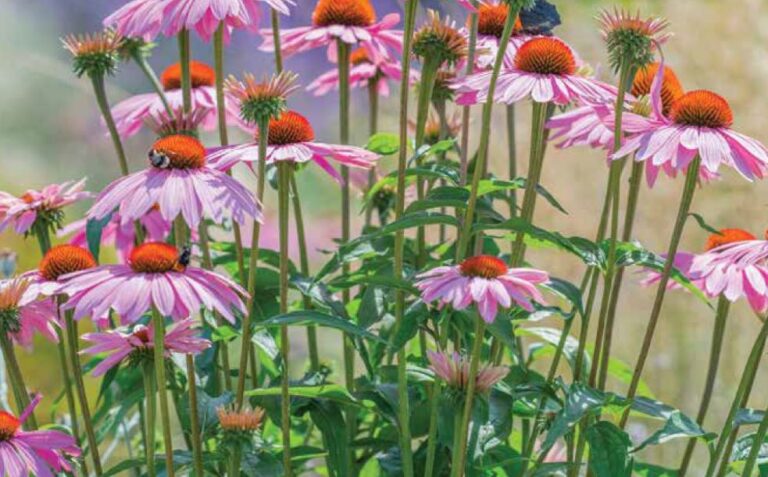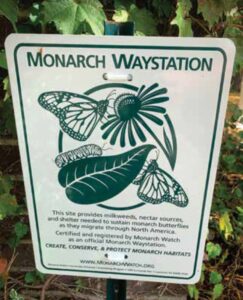The following sustainable landscaping best management practices are excerpted from SFMA’s National BMP guide, Best Management Practices for the Sports Field Manager: A Professional Guide for Sports Field Management. The full guide, as well as a customizable BMP template, is available at https://www.sportsfieldmanagement.org/knowledge_center/bmps/. Part 1 of the sustainable landscaping BMPs section can also be found in the June issue of SportsField Management magazine.
Plant Selection
The fundamental principle for the environmentally sound management of landscapes is “right plant, right place.” Proper plant selection is the most important step in designing a sustainable landscape planting. Use a detailed, completed site analysis to select appropriate plants for the site and ensure successful establishment based on sunlight requirements, soil conditions, and water availability.
Native plants should be an integral component of the landscape design at key focal points and around the property periphery. The goal of species selection in a sustainable landscape is to maintain as close to a natural ecosystem as practical. The majority of the non-sports field areas should be maintained with reduced inputs or left unmown during the growing season, where possible. Retaining as much natural vegetation as possible and supplemental planting of native trees, shrubs and herbaceous vegetation provides the highest quality wildlife habitat. For example, native species such as oak and aster best sustain species of native butterfly and moth caterpillars in a Mid-Atlantic location, while non-native species such as Ginkgo or Zelkova support none. Planting species that attract native insects is the most effective means to maintain and improve biological diversity, as it increases the complexity of the biota the native area can support. The native plant finder website (https://www.nwf.org/NativePlantFinder/Plants) can provide the same kind of species information and rankings by ZIP code.
Irrigation
Regardless of their ability to tolerate drought, all plants typically require supplemental irrigation during establishment. If supplemental irrigation is not available for larger expanses of native areas, the plants should be established at the most ideal time of year to take advantage of naturally occurring rainfall. To increase water-use efficiency and improve plant establishment in landscaped areas, consider hand-watering individual plants for the first several months of the growing season. When irrigation is needed, plants should be watered in the early morning to conserve water and to avoid water loss due to evaporation. Water new trees and shrubs at least once a week to a depth of one foot and more frequently during dry weather. When using a hose, allow the water to trickle out for at least an hour, and move the hose several times around the base of the tree. Keep trees well watered throughout the entire establishment period (one year or more depending on the caliper) with deep, slow watering. Apply at least five gallons when watering from a container, pouring it slowly over the back of a shovel to spread the water. Watering bags are effective tools for applying water slowly.
If trees and shrubs are planted in an area with an existing irrigation system, assess the coverage to determine whether changes should be made to identify areas where efficiency can be improved. Carefully assess landscape watering patterns to minimize spray on impervious surfaces; blockage of spray by plants or other obstructions; and runoff on slopes, clay soils, or compacted sites. Focus on the irrigation of woody plants at or beyond the dripline to promote extensive rooting. Periodically throughout the growing season, check the performance of the landscape irrigation system.
Use of mulch
Mulch conserves soil moisture, mitigates temperature extremes, and reduces weed competition. During the growing season, mulch also serves as a visual reminder to keep mowers and string trimmers away from shrub stems and tree trunks. In winter, mulch helps prevent soil cracks from forming and exposing roots to cold temperatures and winter desiccation. Organic mulches include herbicide-free grass clippings (though avoid applying too deeply to avoid matting and heating the soil); shredded bark; bark chunks; composted sewage sludge; one-year-old wood chips; pine needles; and composted, shredded leaves. Organic mulches are preferred, as non-organic mulches such as stone may add heat stress around annuals and perennials.
Annuals and perennials grow best with no more than 2 inches of mulch. Around trees and shrubs, mulch should be no more than 3 inches deep. With any planting, place mulch between the plants and not on top of the crown or against tree trunks or shrub canes. In the winter after the ground freezes, a deeper layer of coarse mulch (evergreen branches) over bulbs and other perennials can delay or prevent early growth and can be used to protect tender plants. Do not place a new layer of mulch over the old layer each year. Each spring, rake the old mulch to break up any hard crust and add only enough new mulch to maintain a 2- to 3-inch layer.
Pest Management
The same principles and methods identified in the IPM chapter of the SFMA BMP Guide can be applied to landscaped areas. University Extension publications can provide information on the pests of regional concern and provide guidance on pest management techniques to manage them. In addition, many Extension programs have diagnostic laboratories that can be utilized when needed.
Pollinators
Most flowering plants need pollination to reproduce and grow fruit. While some plants are pollinated by wind, many require assistance from insects such as solitary bees, bumble bees, flower flies, and butterflies, as well as other animals (e.g., birds and bats). In the absence of these pollinators, many of the fruits of wild plants would fail to survive.
Pollinators are facing a number of threats that can alter their health and abundance, such as loss of genetic diversity of the plants required for survival, loss of habitat, and exposure to pesticides. Because of the potential for nontarget effects of pesticide products sometimes used in landscape and sports field management, licensed pesticide applicators are trained on the impact that they may have on pollinator species and their habitat.
Incorporating IPM best management practices can reduce the need for pesticide applications often used to maintain healthy dense turfgrass playing surfaces, though pesticides may need to be applied when necessary and allowed. Sports field managers can utilize IPM best management practices that protect pollinators by following these simple steps:
- Maintain landscape, right-of-way areas, woodland or natural areas that border sports fields and other grass areas to reduce pest damage to natural grass playing surfaces.
- Scout for both pests and beneficial insects. Identify and confirm true pests, as well as understand the threshold number when unacceptable pest damage will occur.
- Determine if higher pest thresholds are acceptable in non-play areas.
- Monitor bee/pollinator activity to avoid applying pesticides during peak foraging times.
- Mow to remove flowers that attract pollinators before applying a pesticide.
When pesticides are necessary to provide uniform and safe playing surfaces, being mindful of pollinators includes selecting products with the following types of characteristics:
- Lowest toxicity to all bees/pollinators.
- Short residual toxicity.
- Properties repellent to bees.
Pesticide labels include pollinator protection language that licensed pesticide applicators must follow. In addition, applicators should be aware of the behavior of honeybees, wild bees, and other pollinators, to avoid applying pesticides when and where these insects are present. Numerous documents that provide the basics of pollinator biology useful for pesticide applicators are available, including from the Xerces Society (https://xerces.org/) and university Extension offices.
In addition, the Pollinator Partnership has published visual depictions of honeybee, solitary bee, colony, and general pollinator life cycles that are useful as well (visit https://www.pollinator.org/learning-center/bee-issues).
Due to the potential for drift, caution should be exercised when applying any products near flowering plants, including flowering weeds, that might attract foraging pollinators into the nearby area. Where possible, applications should be delayed until after nearby plants have completed flowering. Applicators are also encouraged to utilize FieldWatch, or similar regional databases, that provide information on any nearby apiaries or specialty crops before applying pesticides on ground properties.
Communication
Addressing any safety-related issues is the highest communication priority for the sports field manager. In addition, communicating the benefits of native areas, pollinator gardens, etc., that add to the landscape provides opportunities for education along with recreation.
Finding opportunities to add signs increases the visibility of your efforts in the non-play areas and the benefits to the community. Articles in community newsletters and on community websites are additional efforts that may be undertaken. Lastly, partnering with birding, apiary and gardening groups can provide another layer of communication with the interested public.



